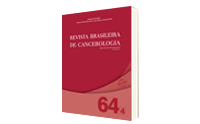Association Between Nutritional Status and Manual Grip Strength in Oncologic Patients in Palliative Care
DOI:
https://doi.org/10.32635/2176-9745.RBC.2018v64n4.196Keywords:
Palliative Care, Neoplasm, Nutritional Status, Malnutrition, Muscle StrengthAbstract
Introduction: Nutritional monitoring in palliative care is extremely important, since levels of mortality, malnutrition and unintentional weight loss occur in the majority of cancer patients. In this way, it is possible to prevent nutritional deficiencies and weight loss, which leads to a worsening nutritional status. Objective: The aim of the study was to evaluate the association between the classification of nutritional status obtained by the patient-generated subjective global assessment (PG-SGA), handgrip strength (HGS) and adductor pollicis muscle (APM) in cancer patients palliative. Method: We evaluated 70 cancer patients enrolled in the exclusive palliative care program. The PG-SGA was used to assess the nutritional status. To evaluate the association of nutritional status with other predictive measures, HGS measurements were performed with a dynamometer and APM with an adipometer. Descriptive statistics and linear regression analysis were used to evaluate the ability of these measures to predict nutritional status. Results: Of the 70 patients, aged between 31 and 101 years, in which 58.6% were male and malnutrition (B+C) was found in 87.2% (n=61) according to PG-SGA. The value of APM was altered in 72.9% (n=51) patients and 42.9% (n=30) in HGS. HGS was associated with PG-SGA (b=-0.273, p=0.04) and APM didn’t (b=-0,124; p=0.546); therefore, only HGS was a good predictor of nutritional status in this study. Conclusion: It’s suggested the use of HGS to evaluate nutritional status in palliative cancer patients.Downloads
Download data is not yet available.
Downloads
Published
2018-12-31
How to Cite
1.
Silva EHE da, Borges FM, Cruz FCS da, Pena G das G. Association Between Nutritional Status and Manual Grip Strength in Oncologic Patients in Palliative Care. Rev. Bras. Cancerol. [Internet]. 2018 Dec. 31 [cited 2025 Dec. 15];64(4):479-87. Available from: https://rbc.inca.gov.br/index.php/revista/article/view/196
Issue
Section
ORIGINAL ARTICLE









